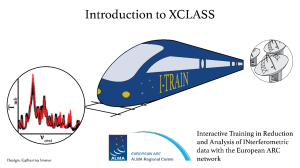The European ARC Network invites users to an introduction to the eXtended CASA Line Analysis Software Suite (XCLASS) on February 16th, 11:00 CET [Zoom].
I-TRAIN #22: Introduction to XCLASS

This tutorial will provide an introduction to the XCLASS package providing a couple of new functions for modelling interferometric and single dish data. XCLASS produces physical parameter fits for all molecules in a dataset. This also allows line identification, but provides much more information. All lines of a species in a given data range are fitted simultaneously with a physical model, which reduces the risk of misassignments due to blends, and allows for robust identifications of species. This is because the method allows checking that all lines that should be there are there, with the expected strength.
For this purpose, XCLASS models a spectrum by solving the radiative transfer equation for an isothermal object in one dimension (detection equation) assuming LTE. That means that the source function is given by the Planck function of an excitation temperature, which is constant for all transitions, but not necessarily equal to the kinetic temperature. XCLASS is designed to describe line-rich sources which often have high densities, so that LTE is a reasonable approximation. Molecular data required by this function are taken from an embedded SQLite3 database containing entries from the Cologne Database for Molecular Spectroscopy CDMS) and JPL using the Virtual Atomic and Molecular Data Center (VAMDC) portal. XCLASS is able to model a spectrum with an arbitrary number of molecules / RRLs.
The duration of this training session will be about one hour followed by a Q&A session. If you have any questions, please contact Thomas Möller at moeller@ph1.uni-koeln.de.
Tutors: Thomas Möller
Note: The tutor's presentation will be recorded and an edited version of the recording will be posted in the Science Portal [I-TRAIN] after the session. The interactive Q&A will not be recorded.

